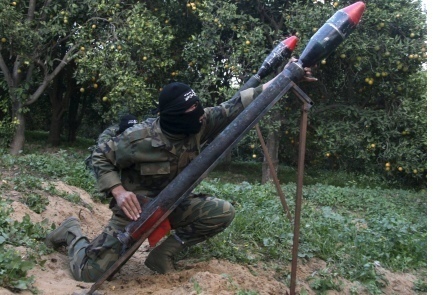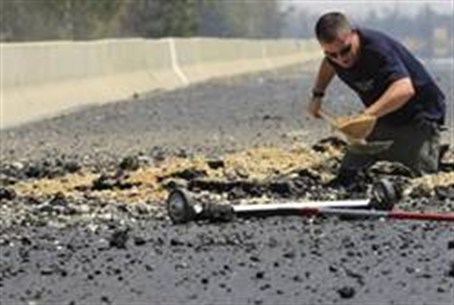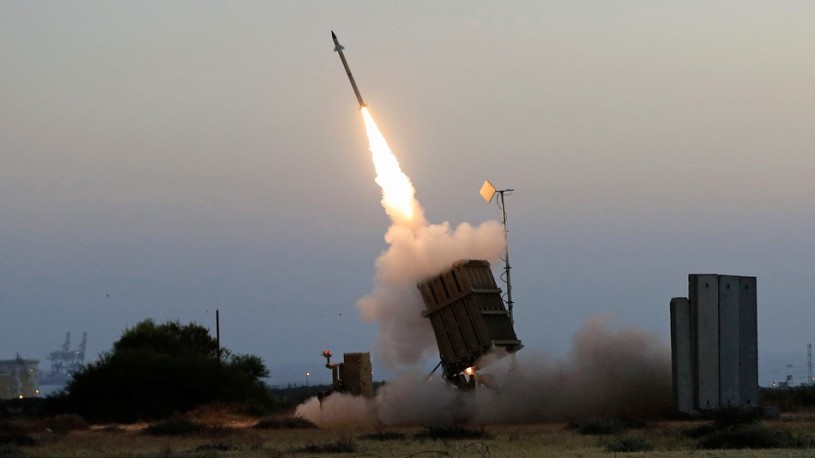Not much needs to be said on the famous missile defense system, the Iron Dome.
A game changing system, and the only one of its kind in the world. The Iron Dome is capable of shooting down short range rockets, mortars and even 155mm artillery shells! And this is the most in depth story you will find of its development and present day status.
The game changing system is so successful it is said to have strategic implications by actually preventing a full blown war in Gaza (which is also a source of criticism, BTW, but more of that in a different article).

The real game changing component of the Iron Dome is the radar, which is defacto the brain of the system. It’s made by sub contractor Elta, and it’s scientific definition is multi mission radar because handles multiple tasks simultaneously. It identifies and tracks various incoming threats like Rockets, planes, UAV’s & drones; Calculates the projectiles exact landing location; Pin points the exact location from where the projectiles were fired; Directs fire to that exact location; Activate air raid sirens in the area where the incoming threat is calculated to land and more.
Previously the above tasks were each conducted by separate systems and radars. They all needed a sophisticated command and control system to coordinate all of them and tie the strings together. Now it is all in system.
The actual development of the Iron Dome was lightning speed! It started in 2008, first test in 2009 and in 2011 was both declared operational and first combat interception happened. System is made by Rafael, along with a variety of subcontractors, most Israeli. One of the foreign subcontractors is Raytheon, whom is actually an official partner in the program, and provides a variety of internal interceptor components. Each missile weights 90 KG and is 3 meters long and the diameter is 160 mm. So far more than 2k missiles were fired at incoming rockets with an 89% interception rate.

The Cost is 50 Million per battery and 40K per each interceptor missile, called “Tamir”. At present, according to public sources, there are 10 batteries spread around Israel which are suppose to cover all population centers and other important installations. Each system includes 3-4 launchers and capable of carrying 20 missiles per launcher. The Funding is partly Israeli and partly the US and even Singapore. As with other systems the US partly funds, they get access full access to the technology which they use on their own systems along with some of the parts actually being made in the US.
The system now also has a naval version, C-Dome, which was declared operational in 2017 and is already stationed in mid sea protecting Israels Gas rigs (video below in Hebrew).
Until now it was exported to Azerbaijan, Romania ,and the US as and even, according to one report, also Saudi Arabia (although, naturally, its impossible to know how credible that source is). Parts of the system are also exported to Britain to be part of their own indigenous system – Sky Sabre. Additionally, so far 100 radar units were exported to 12 different countries. According to reports, Turkey is also developing a similar system, called Golden cage, although it is unclear how far they are in the development phase.
This missile is almost completely autonomous. It identifies the incoming projectiles, calculates its exact projected landing spot and whether or not to intercept it (although if a soldier in the battery actually presses the “Launch” button or not or from a different aerial defense command center or if it is even done automatically is unclear). Of course the AI’s interception decision is based if it will fall in a populated are or not.
And that is one of the specialties of the Iron Dome. Its automated AI decision if the Iron Dome will endanger urban areas and important installations or not and hence if Iron Dome will intercept it or not.
And also regarding hitting an urban area or not – as you know from other essays already – the IDF is big on calculating War economics. There were skeptics who said look, “how much one of those cheap Qassem rockets cost” VS 1 Iron Dome interceptor costs. Off course, the calculation is how much damage is done when projectiles hit urban areas, NOT rocket vs rocket cost. And we are not even talking about the physical and emotional cost which cannot be priced (aside from health insurance costs which ARE part of the calculations).
According to Rafael, they have the exact calculation of how much money the Iron dome saved by knocking out projectiles in air. For some reason, the calculation is classified to the general public. We know more than 3200 interceptors were fired, which means about 1600 projectiles which would hit urban areas if they were not intercepted. The cost of 3200 Iron Dome interceptors is 3200*40000 = 128 million. Would 1600 projectiles hitting Urban areas really only cost only 128 million (The IDF decided they will still shoot 2 missiles for every interception at least until the interception rate reaches 100% and not 89%)??
How much would that cost if all the missiles landed? As mentioned, only Rafael has this exact classified info, but my gut feeling says at least 2-3 Billion USD and maybe much more. Here is a comparison in the 2nd Lebanon war in 2006, BEFORE Israel had Iron Dome (or other missiles like David’s sling which could also down some of Hezbollah missiles) and in which ALL the missiles landed “safely”. It lasted 33 days and almost 4K missiles were fired at Israel but the majority fell in open areas. The total civilian economic losses were around 5 Billion USD however too much critical info is missing a real comparison (how many missiles landed in Urban areas, how were the economic losses calculated and etc).
Hence, you can safely say, in addition to saving human lives, Iron Dome is foremost economic cost cutting optimization.
The basic need for the Iron Dome arouse around 2001 and onward, when the first Qassam rockets started landing. But nothing was done because the firing of the rockets against Israel wasn’t massive, the rockets were very limited in range but also because nobody believed such a system can be developed. In time the rocket attacks became more constant and their range grew until cities like Ashdod and Beer Sheva came under attack. Something clearly needed to be done, but the only viable option was offensive or even complete reoccupation of Gaza.


The whole decision making process of the Iron Dome was done in the upper echlons of the Israeli Government. Specifically, between the rotating Defense ministers, Amir Peretz and Ehud Barak, and the PM at the time, Ehud Olmert between 2005 and 2011 (when the system became operational). Eventually the systems credit is given today to Amir Peretz although it was a mutual decision between all three. What is less known is the development process of the engineers and designers in the factories and drawing boards of this system. Their story is detailed in Mako-Even though it is an old story, it was never really detailed in English
Uzi, the head of the project, worked all his life in discreet projects but his life changed in 2006. He had, like so many others in northern Isreal, sit in shelters while being bombarded by Hezbollah rockets in the Rafael factories in northern. Immediately after the war an agreement was signed between Rafael and the Israeli MOD for the development of the project. “Never has there been so much publicity in a project we developed” Uzi says, a thing that added a stressful dimension to the work they were not use to.
Very few people believed in the chances of success of the project. Colleagues, missile experts and others said it can’t be developed or won’t meet the deadlines (just like they were told about the Trophy system, we detailed in our article on its development). According to UZI, a US delegation evaluating it even gave it a 10% chance success rate chance.
Most of the Major players of the defense industry took part in this project. Rafael at the helm (design and macro engineering), IAI the Radar (specifically Elta, which is part of IAI), Mprest the command and control, in addition to many additional ones. UZI himself was the project manager and the one who connected the dots.
In addition to UZI there were 3 more whom worked on the brains of the system and were defacto the driving force behind it. They were told they needed something cheap and can hit a missile the size of a “water bottle”. It was on the verge of “science fiction” as Offir, one of the four says. “We worked round the clock for years and in huge stress. I have 3 kids that I barely know. We worked for months with 4-5 hours of sleep a night. Running to work, working 2 consecutive shifts, return, sleep a few hours. At night I would dream of solutions for the system, wake up in the morning, and on the way to work, phones and more thoughts about the system. Mornings to evenings live, breath, eat, dream – Iron dome.” It went on like that from 2008, the year they started development process, until 2011 when it became operational.
In order to develop the system as fast as possible, UZI – head of the program, at the beginning assembled 2 teams to come up with a solution competing solutions. After a year, the team that came up with what is today Iron dome, won. The other team that came up with the other solution and was made of 15 developers, whatever it was. They were told politely “thanks for your work, but we chose the other systems”. According to UZI, “We didn’t come here to make friends; we came here to make a working system that does the job. And in this process, yes, sometimes you need to make hard and unpleasant decisions, and so we made them and moved on.”
After a year and 8 months of hard work they were ready for the first test to be conducted in the Negev desert. “I was about as excited like the birth of my first son and every 5 minutes I ran to the bathroom because of repeated delays in the test because of all kinds of all kinds of constraints in the testing facility.” Offir says
The whole report from mako about he developers story (unfortunately only in Hebrew) and in 08:12 is the first experiment in 2009.
After the success of the first successful experiment there was jubilation. “it’s something that’s very hard to explain and you only see it in soccer matches, at the final moments, when there is a winning goal. A group of adults, jumping, hugging, and shaking hands with childish enthusiasm. That is something I never saw anywhere except in a soccer match. But here is a group of Technion alumni. (Technion, Israel’s MIT), a surrealistic event”. Are there bonuses? UZI -“absolutely, after every successful test there is compensation. You can’t say it will make us rich, but there was definitely good compensation”. Offir – “Anybody whom went to work in high tech would make much more money. Everybody is here for the Zionism and for the objective. Zionism is not a dirty word and we were doing it to defend our homes.”
The system became operational in 2011 and the first combat proven interception happened in the 7th of April that year when a Grad missile was intercepted. And the rest, like they say, is history. The system intercepted since then, thousands of missiles and saving, no doubt, thousands of lives and billions of USD. In addition, the system is actually strategic, as it prevents Israel from going to war and physically occupying Gaza completely (which is actually also a source of criticism, believe it or not). That, in turn would also cost thousands of lives, for both sides, along with a slew of other implications.
